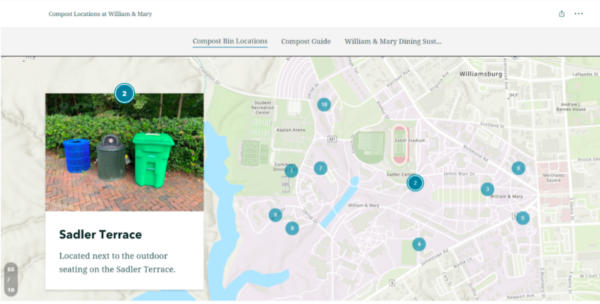The Campus Compost Initiative Needs YOU!
By Isabella Chalfant ’22
William & Mary is not only a university that values the cultivation of knowledge within the student body, but also strives to implement sustainable practices into operations. Many students on campus express a care for sustainability and preserving Earth and its biodiversity. Such practices may include limiting water and electricity use, or recycling plastics and glass; but there is one other practice that our campus continues to expand upon: Composting.
Composting is an important part of creating a sustainable future for generations. This practice takes food waste and other compostable materials out of landfills and converts it into soils that can be used for gardening and farming. When these materials end up in landfills they decompose without the presence of oxygen, which creates methane, a greenhouse gas approximately 23 times more palpable than carbon dioxide. Promoting programs that limit food waste, like composting and diverting excess food to shelters are fantastic examples of how sustainability can be incorporated into food programs.

Map of W&M’s compost bin locations – view the interactive map.
Currently, William & Mary has a composting program in place that includes the placement of ten compost bins around campus. These bins are monitored by 15 dining sustainability interns, who move the bins from their locations to compost pick-up stations where the food waste is then collected by Natural Organic Processing Enterprises (NOPE). William & Mary partners with NOPE, a composting center based in Richmond, Virginia, to handle all food waste processing from the W&M campus.
During the last semester, W&M’s Sustainability Ambassadors program, which is a coalition of a few chosen students that work with faculty members on different sustainable projects, had an initiative that focused on expanding the compost program on campus. While there are many ways to expand such a program, there is one main enterprise that had the most success during the Fall 2021 semester: obtaining new compost bins. There are 3 new compost bins that are slated to be on campus in the Spring, one will be located by Swem Library, another by Landrum Hall, and the last by the Sunken Garden outside of McGlothlin-Street Hall. These areas were chosen for their high student foot traffic. The addition of new compost bins will increase the tonnage of collected compostable items on campus allowing for more waste to be intercepted before going into landfills. However, in order for the use of compost bins on campus to be successful in reducing food waste, the student body must first be informed of the importance of composting and how the process works.
There are many ways to convert food waste to compost, such as vermiculture practices and thermophilic processes. Vermiculture is composting through the use of certain species of earthworms. While this is not a new process, it is a newly emerging composting industry that may prove to be incredibly lucrative in the future. However, the composting done at NOPE is thermophilic. This kind of composting uses microbes that break down food waste at temperatures upwards of 70 degrees Celsius. All composting processes that involve microbes and the natural processes of breaking down compostables are known as thermophilic composting through aerobic digestion; this includes composting done locally by people in their backyards. Aerobic composting simply means that it occurs in the presence of oxygen, thereby bypassing the creation of methane.
Due to the potency of methane, food waste contributes to about 8% of global greenhouse gas emissions. While it may not seem like a very large percentage, that totals to anywhere from 87.45 to 94.56 gigatons of greenhouse gases. A gigaton can be measured as about 142 million African Elephants. Food waste can be cut down significantly through composting and other sustainable practices such as buying local produce and food donation. Every ton of food waste taken out of landfills and turned into compost can not only limit greenhouse gas emissions, but will also put nutrients back into the soil. The use of compost in farming can reduce the utilization of artificial fertilizers that cause harmful pollution in water systems. Thus not only reducing food waste but also diminishing other such anthropogenic (human based) impacts like water pollution. The nutrient rich compost produced by NOPE is sold to garden centers and farms. NOPE has a program called “Compost Credits,” where for every ton of food waste given to and processed by NOPE, institutions like W&M can get 40 lbs. of compost to be used in their own campus gardens or donate to charities and farms for growing gardens and vegetables.
However, without the students composting their compostables on campus, there is no limiting greenhouse gas emissions. Campus compost is wholly dependent on the student body putting their compostable items in the bins and not throwing “contaminants” in with the food waste. Contamination refers to anything that isn’t compostable, and because something is biodegradable that doesn’t mean that it is compostable. The difference between the two is very important in knowing what to put in the green compost bins on campus, and what to exclude from the bins. Most compost bins on campus have composting guides on them to show what can be composted and what cannot be. Technically speaking, plastics are biodegradable, but they degrade in over 400 years. That is the catch when it comes to the differences between compostable and biodegradable products. The composting plants at NOPE can only accept loads that have 2% or less contamination, otherwise the compost collected by campuses will go straight into landfills because the waste cannot be processed with the facilities’ equipment.
Dining Sustainability implores students to compost items that are in fact compostable and help to mitigate contamination in the bins. The more food waste and compostable materials diverted from landfills and converted to compost, the less greenhouse gases enter the atmosphere. William & Mary has an interactive map of all the composting locations on campus with more to come. The interactive map also contains a composting guide that details what can and cannot be composted. The campus composting program cannot work without the student body, please compost and help make a difference in the fight for sustainable practices.




No comments.
Comments are currently closed. Comments are closed on all posts older than one year, and for those in our archive.